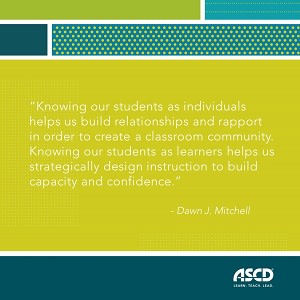Quality instruction does not materialize out of nowhere, and certainly not without demands placed on schools and educators. Every few years, districts engage in an assessment of their progress and develop a new strategic plan to identify district priorities thoughtfully, using school-improvement recommendations from state education agencies and national organizations to outline areas of growth. These improvement plans also determine funding for teachers’ professional development and serve to identify committee work and change conversations that will propel the district into its next five years.
Every leader’s job—at the school and district level—is to pull from these strategic planning documents and articulate school improvement areas without overwhelming their staff. It’s no secret that initiative overload is a common concern in schools across the country, and it will perpetuate if leaders cannot integrate school improvement plans with a common vision for instruction. When leaders can blend new plans with a shared instructional vision, they help make sense of new initiatives and support educators in understanding the why and how of school improvement efforts. District plans, after all, have one fundamental purpose: improving student outcomes.
Developing Your Instructional Vision
When leaders connect school improvement plans to the work of improving student outcomes, they create strategic purpose, helping staff refocus on instruction that supports the district’s vision. District leaders could craft a vision of high-quality instruction on their own, but to truly achieve a vision of shared ownership, assembling a team of teachers, instructional leaders, and principals is critical.
District leaders do not have to start from scratch. Research organizations and state education agencies have already defined quality instruction for school districts, and pulling from this information will support developing a vision that meets the criteria of state academic frameworks. There are also great examples from districts like Hartford Public Schools in Connecticut and Portland Public Schools in Oregon that can support teams in working toward a final product that can be used to communicate expectations for quality instruction with staff. Every leader, whether school- or district-based, should sit down with these documents and ask their team these three fundamental questions:
- What do we believe are critical components to high-quality instruction?
- What key areas of instruction do we want to focus on as a district?
- What does proficiency look like across these key areas?
Beginning with these three questions can help district teams develop a local definition for instruction that supports district strategic plans and school improvement plans. From here, the team can begin developing a common rubric for instruction that supports teacher self-assessment.
As leaders, we should always practice what we preach—a common rubric models how to set clear expectations for improvement for our teachers along a continuum of instructional proficiency. For example, your district might choose differentiation as one key area to focus on. You might then decide that teacher growth in this area would look like:
Proficiency Level | Components of Teacher Growth for this Level (Differentiation) |
|---|---|
| Beginning | Lessons offer high, medium, and low options for student practice to support differentiation; however, differentiated experiences do not extend beyond student practice. |
| Approaching | Lessons offer varied options for student practice and assessment, both of which extend beyond high, medium, and low tasks to include integrating choice. |
| Proficient | Lessons offer students flexibility in engaging in their learning, including practice and assessment, where choice allows for students to engage in varied learning experiences based on their learner profile to meet or exceed the lesson standard. |
| Exemplary | Lessons include pre-assessment and self-assessment, allowing students flexibility in their engagement with the lesson based on a flexible learner profile to support demonstration of mastery at or beyond the lesson standard. |
When your instructional vision team can define the continuum of growth for each key area, these definitions will provide clarity and build a pathway toward proficiency. Moreover, your team can identify critical conversations and professional learning opportunities that will help move all staff forward, regardless of their experience.
Improving Instruction Through Professional Learning
An instructional vision should support district priorities without becoming outdated or contradictory over time. It should identify what teaching and learning should always look like: by focusing on pedagogical goals, rather than a particular tool or resource, districts set themselves up for longer term success.
By focusing on pedagogical goals, rather than a particular tool or resource, districts set themselves up for longer term success.
Approaching an instructional vision in this way will make it easy to shift professional development opportunities without muddying the district’s focus. Most importantly, the vision should support differentiated PD so that all staff are getting what they need to continue to move toward proficiency in each of the district’s key areas of instruction.
Returning to the key area of differentiation, the team might identify the following critical skills at each proficiency level:
Proficiency Level | Critical Skills for this Level (Differentiation) |
|---|---|
| Beginning | Offer high, medium, and low options for student practice. |
| Approaching | Offer high, medium, and low options for student practice and assessment. Offer choice for student practice and assessment. |
| Proficient | Leverage learner profiles to support flexible learning, practice, and assessment. Embed opportunities for students to meet or exceed the lesson standard through learning, practice, and assessment. |
| Exemplary | Embed pre-assessment and self-assessment into lessons and units. Support student ownership in learner profiles to support flexible learning, practice, and assessment. Embed opportunities for students to meet or exceed the lesson standard through learning, practice, and assessment. |
Pulling out critical skills at each proficiency level allows your team to plan differentiated PD where every teacher has an entry point. The goal is, of course, for all teachers to be proficient in each practice, with many teachers able to perform at the“exemplary” level for some lessons or units. Exemplary is challenging to reach all the time, but if we know what it looks like, we can continue to support teachers in working toward it while maintaining proficiency in each key area.
A Shared Understanding of Quality Instruction
As a district leader, your instructional vision must be a part of everything you do, in perpetuity. Once your team has identified the key areas of the district instructional vision and developed a rubric defining what proficiency looks like for each key area, the vision should become the handbook that guides conversations and district decision-making. Every speaker, change conversation, and professional learning community should focus on these key areas.
As a district leader, your instructional vision must be a part of everything you do, in perpetuity.
When leaders craft a vision for instruction in this way, they can center school improvement conversations with a shared understanding of intended outcomes and a clear vision for what the classroom experience must look like to achieve its goals. So, leaders: Get to work and guide your teams toward defining high-quality instruction together.








